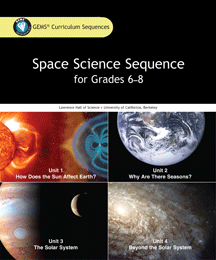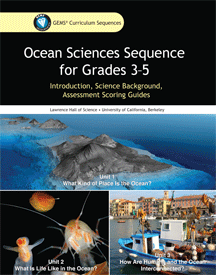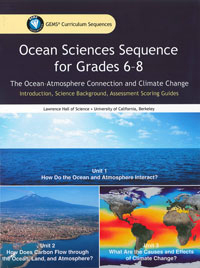GEMS Curriculum Sequences
|
What are the benefits of GEMS Sequences?
GEMS Curriculum Sequences offer extensive benefits, including greater coherence as units build on one another; increased scientific depth, with science concepts presented in a manner that supports the teacher; increased educational depth with extensive pedagogical support; formative and summative assessment tools; and, readings and technology components for use with students. A detailed overview of the GEMS Curriculum Sequences approach is provided in this brief 2-page document.
George Nelson, former shuttle astronaut and now education researcher, said in his keynote address to the attendees of a NASA EPO (Education and Public Outreach) conference in Chicago that, "We would do well to become familiar with these materials and promote them to teachers and schools rather than trying to create something else." He further commented that, "These instructional materials responded to the challenge I made a few years ago to produce something that incorporates the best of NASA's cutting edge research to help children learn grade-level appropriate ideas in astronomy in the time available." Read the full text of the address here.
More details on the specific units currently available and in development can be found below.
Where can I purchase the units?
The sequences listed above are all available from our publisher, Carolina Curriculum. For details on product pricing for each of the sequences please call Carolina Curriculum at 800 334-5551.
Check out a recent 2014 CLEAN Network Teleconference call that was conducted with the Lawrence Hall of Science’s Catherine Halversen, Emily Weiss, and Traci Wierman. View slides and listen to an audio-recording of the call.
Please view the video below for an overview of the Curriculum Sequences concept in action: |
The Alignment with the Next Generation Science Standards for Ocean Sciences Sequences and Space Science Sequences can be found here as a PDF for your review. |
|
|
The Space Science Units:
The space science curriculum programs were developed with NASA and with leading astronomy educators and researchers, assessment experts, and GEMS curriculum development staff. These sequences are a response to the need for excellent, coherent, standards-based, supplementary curriculum that can be taught in the amount of time teachers can reasonably allot for space sciences. The content of each of the two sequences is summarized below.
A brief presentation outlining some of the key features of the Space Science Sequences was shown at the National Science Teacher's Association convention in New Orleans in March 2009, and is available for download here. (This is a PowerPoint file and you must have the program to view the file.)
Sequences provide a uniquely flexible curriculum. For example, the GEMS Space Science Sequence for 6–8 is comprised of 4 units, each about two weeks long or less. It is possible to teach all the units during a single years' course of study; or, individual units can be taught each year over two to three years. Not all of the units in a sequence must be taught—each can stand alone if necessary. This flexibility allows schools to determine when to teach specific content based on their standards and curriculum requirements. |

|
| |
Unit 1 |
Unit 2 |
Unit 3 |
Unit 4 |
Space Science Grades 3–5 |
How Big and How Far?
(9 class sessions)
|
Earth's Shape
and Gravity
(6 class sessions) |
How Does the Earth Move?
(4 class sessions) |
Moon Phases
and Eclipses
(5 class sessions) |
Space Science Grades
6-8
|
How Does the
Sun Affect
the Earth?
(8 class sessions)
|
Why Are
There Seasons?
(6 class sessions) |
The Solar
System
(11 class sessions) |
Beyond the
Solar System
(7 class sessions)
+ 1 optional session |
In addition to great flexibility, GEMS Curriculum Sequences are being developed with close attention to the requirements of standards-based education, and the realities of the priorities placed on science in today's schools. These research-based materials are aligned to the National Science Education Standards and to other key concepts and abilities in state/district frameworks, with careful attention to key concepts that are commonly misunderstood. We have based the time allotted for each topic on feedback received from a wide range of schools as to how much time they can realistically spend teaching that material.
GEMS Space Science Sequences each include a CD-ROM with multimedia content and additional resources. In addition, both units are provided with teacher's guide (including extensive science background and an assessment system), a materials kit supporting the activities, and copymasters for student sheets.
The attention to flexibility, standards requirements, inquiry skills, and real-world time constraints make for a curriculum that meets the needs of a wide range of schools and their unique situations.
The Ocean Sciences Units:
The Ocean Sciences Sequence for Grades 3–5 was developed with support from NOAA and in partnership with the NOAA Jacques Cousteau National Estuarine Research Reserve and Education Center, and Rutgers University Institute of Marine & Coastal Sciences, and other partners. The sequences are designed based on the results of an extensive study which has helped us identify which key standards occur in selected states at each grade, and which content areas are most closely aligned to the Ocean Literacy Essential Principles. These sequences will provide educators the tools to teach essential science concepts in the unique and important context of ocean sciences.
The Ocean Sciences Sequence for Grades 6–8: The Ocean–Atmosphere Connection and Climate Change was developed with support from NOAA and in partnership with Rutgers University Institute of Marine & Coastal Sciences, and other partners. The sequences are correlated to the Next Generation Science Standards (NGSS), with an emphasis on the Practices of Science as called for in NGSS and A Framework for K-12 Science Education. They also have significant overlap with the Common Core State Standards for English Language Arts & Literacy in History/Social Studies, Science, and Technical Subjects and are closely aligned to Ocean Literacy: The Essential Principles and Fundamental Concepts of Ocean Sciences for Learners of All Ages. These sequences will provide educators the tools to teach essential science concepts in the unique and important context of climate change.
Like the Grades 3–5 units, the Ocean Sciences Sequence for Grades 6–8 were developed with support from NOAA and in partnership with Rutgers University Institute of Marine & Coastal Sciences, and other partners. These units extend our work to create a curriculum that further supports the Ocean Literacy Essential Principles.
The Ocean Sciences Sequence for Grades 3–5 and 6–8 are fully described, along with sample units and resources, on our MARE: Marine Activities, Resources & Education site. |
  |
Effectiveness Research Reports:
We have three research reports available which look at the effectiveness of the curriculum seqeunces, as described below:
A report conducted by the Center for Research, Evaluation, and Assessment (REA) examines student learning, as shown by unit pre/post assessment change, in the GEMS Space Science Sequence for Grades 6–8. REA, based at Lawrence Hall of Science, conducts both internal and external evaluation and research in mathematics and science education. Evaluation questions for this project took into consideration concerns and interests of curriculum funders, the curriculum development team, and potential users. Evidence of student learning is of primary interest to all stakeholders and is therefore the overarching question for this evaluation. Download the report here.
Two studies were conducted by a team at Florida State University. The first is titled, "Comparing the Efficacy of Reform-Based and Traditional/Verification Curricula to Support Student Learning about Space Science" and reports on the relationship between reform-based curriculum and the development of students’ knowledge of and attitudes toward space science. It can be downloaded here. The second, "Learning about Space Science: Comparing the efficacy of reform based teaching with a traditional/verifications approach" explores the relationship between curriculum and teachers’ knowledge and beliefs about teaching. The full report can be downloaded here. |

